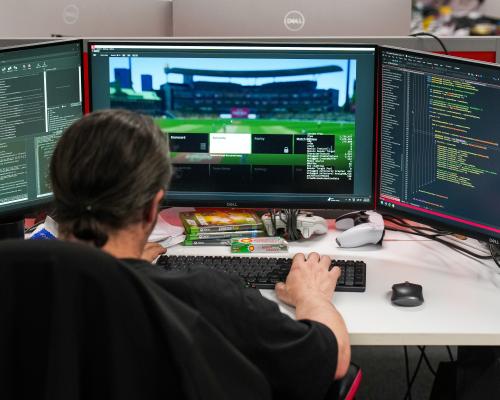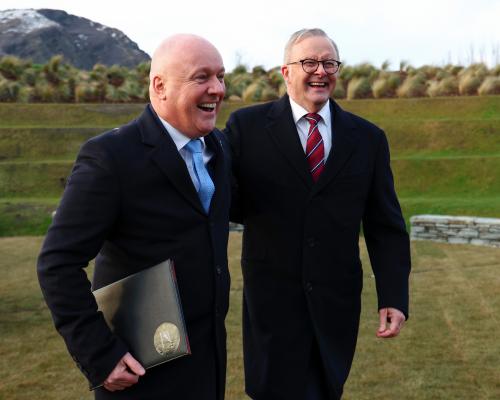
The idea that video games are not “serious things”, says Ross Symons, overlooks the benefits they offer to gamers feeling isolated.
“One thing that struck me during Covid is that games were the way that people connected and stayed together.”
The chief executive of Big Ant Studios, a Melbourne-based game developer, recalls when in 2010 the then opposition leader Tony Abbott dismissed the national broadband network as being for “internet-based television, video entertainment and gaming”.
Symons says that dismissiveness of the video game industry has not stood the test of time.
Last year alone, Australians spent $3.8bn on video games, according to the Interactive Games and Entertainment Association (IGEA). The sector is small compared to large game development nations such as Canada – but that is slowly changing.
In 2023, the federal government brought in the digital games tax offset (DGTO), which allows developers who make or port (develop games for systems that aren’t the ones they were originally on) games in Australia to claim a 30% refundable income tax offset. It applies to companies which incur at least $500,000 in qualifying Australian development expenditure and is capped at $20m per company.
Ron Curry, the chief executive of the IGEA, says in 2020-21 there were about 1,300 employees in the gaming industry in Australia – a figure which has now almost doubled.
The Australian game development sector now accounts for 2,465 full-time workers and earned $339.1m in revenue in the financial year of 2023-24. “That shows an almost 100% increase in employment and revenue has grown about 85%,” he says.
“The DGTO pulled a number of levers. Australia was a very expensive place to make games – we were the only developed country without any sort of rebate or offset. So it fixed that, so it brought us back in line with other developed countries.”
Sign up: AU Breaking News email
Curry says it signalled to the rest of the world there was confidence in the industry from government, and – in conjunction with state and territory grants to the sector – it made Australia a “healthy environment to operate in” and generated confidence from investors, game publishers and prospective employees.
Interstate competition and legacy-building
Serge Zebian, partner at Playwright Consulting, a firm that advises gaming companies on accounting matters, says the offset has made an “enormous difference” for companies hiring people in Australia and that momentum is starting to flow.
“We’re making all the international studios aware of it, and some already are just from existing relationships with Australian vendors. But … now a lot of international studios are looking [toward] Australia. My clients’ proposals are progressing really fast up the queue.”
Zebian says NSW used to be the home for film while Victoria had the reputation as a games development hub, but competition is increasing. Queensland has added a 15% rebate on top of the federal government’s 30% with a threshold of $250,000. In Victoria, the rebate is 10% or 15%, depending on shareholding, with a threshold of $500,000.
“What we’re finding is a lot of indies [independent game studios] are … moving up to Queensland,” Zebian says.
French developer Gameloft opened its Brisbane studio in 2014. The studio was behind the resurrection of iconic gaming character Carmen Sandiego this year on mobile, Netflix, Xbox, PlayStation, PC, and Nintendo Switch.
Manea Castet, the studio head in Brisbane, says he grew up playing the Carmen Sandiego games with his father. He found the character scary: Sandiego is a thief, after all, who you have to chase all over the world. For Castet, to come back and be able to make the new game and have players instead assume the role of Sandiego was a “fun twist”.
Castet says Gameloft’s Brisbane studio is the only one within the company experiencing large growth, expanding from 55 employees two years ago to 217 today. Castet says it allows the studio to work on two games at once and have more complete development of the game from design, tech, audio, quality assurance and marketing.
“Everywhere in the world, it’s shifting … there is still a lot of money to be [made in] the video game industry, so having Australia pushing for that now, I think it’s super smart.”
Development challenges
Big Ant Studios found itself at the centre of controversy with the release of their Rugby League 26 game in July. Users complained about bugs in the game at launch, including jerseys with the wrong numbers on them and server errors making it difficult to play the game.
Symons says it was a “very good day” when numerous patches were rolled out to improve the game. He blamed tight deadlines for the release of the game to coincide with the NRL season and last-minute changes to the game.
“We were forced to make a hell of a lot of change in the game, 1,200 changes in the week before we release[d], and these changes were to do with betting sponsors, alcohol sponsors and all sorts,” he says. “So we sat there stripping the hell out of the game, still having to meet our day. So that was tough.”
Gambling and alcohol company logos that are featured on player jerseys in real life were removed from the game prior to release amid growing concern about marketing of those products to under-18s. Symons also says the company underestimated demand on the day the game went on sale; it sold six times more than their expectations, leading to server issues which he says have since been resolved.
Big Ant had around 50 employees until the tax offset came in, which allowed the company to expand to 147 employees, Symons says. “It allows us to be competitive with every other place on the planet.”
The studios say a tight jobs market, where games development skills are often sought out by other industries including artificial intelligence, makes it more difficult to grow.
Curry says the industry is proud participants have transferrable skills, but it makes it competitive for talent. Secure jobs, commensurate salaries and an immigration system that attracts senior talent would help recruiting, he adds.
“We know when you bring senior talent into a country, they act as an accelerator for those people that they’re training,” he says. “If you want to get a developer into Canada, you can do it in as little as two weeks through their system. We know people have taken up two years and beyond to get into Australia.”
“That just doesn’t work when you’re in a field that’s quickly moving.”






